Flavourful, appetizing & comforting, soy sauce chicken is a classic dish that can be served in many delicious ways. This recipe introduces an approachable, less labour-intensive method to cook it at home.
What is Soy Sauce Chicken
Soy sauce chicken, also known as See Yao Gai/豉油鸡 in Cantonese, is a classic dish loved by many. Although not cooked in an oven or over an open fire like Char Siu, roast goose, etc., it’s considered to be a Siu Mei dish sold at Cantonese style BBQ shops.
Essentially, it’s whole chicken braised in a soy sauce flavoured broth which provides a strong aromatic taste and an appetizing colour on the skin. Chopped small and served with a shiny sauce, soy sauce chicken can be found both in luxury festive feasts and in humble one-bowl rice/noodle dishes.
A simplified version without compromising on flavour
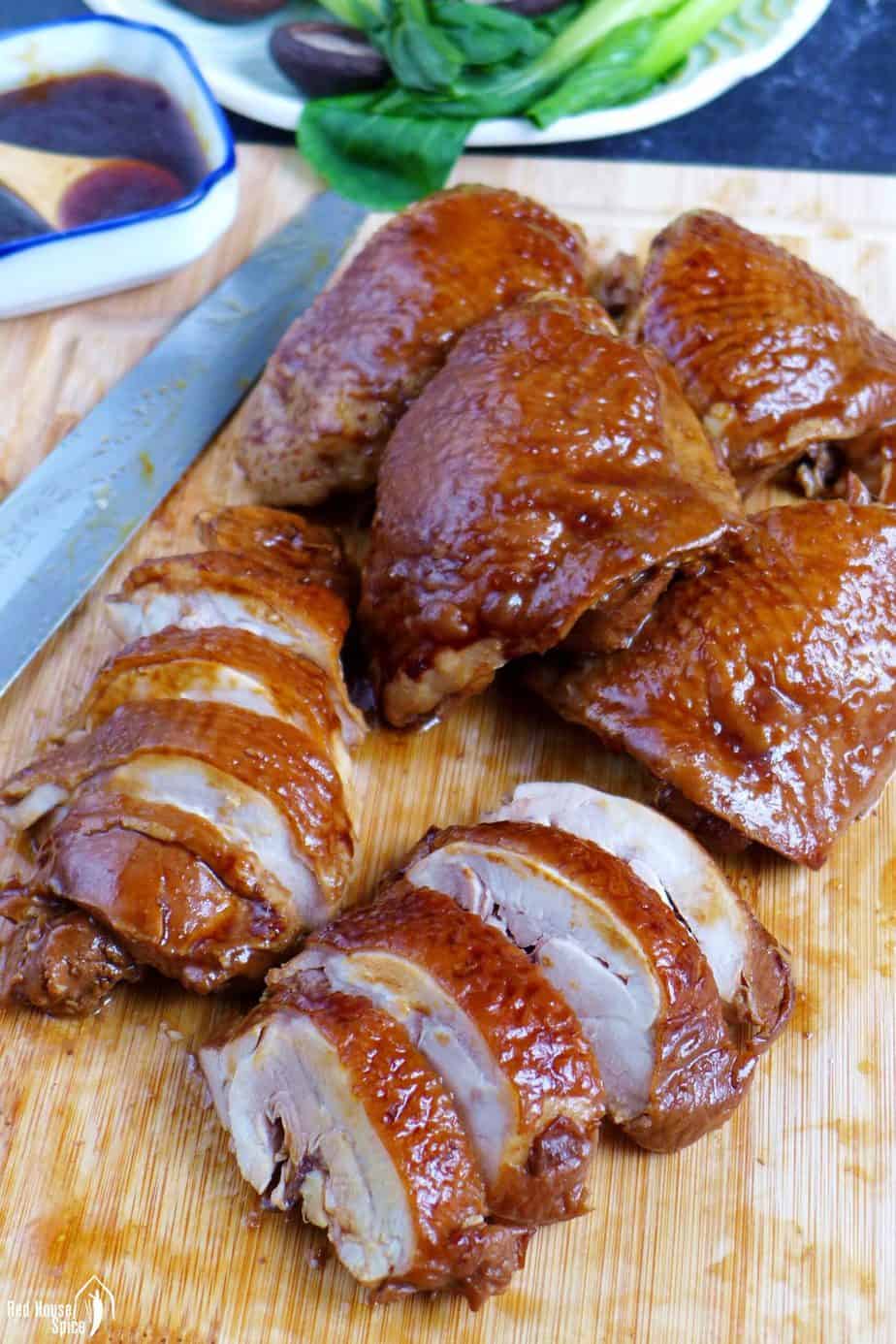
Instead of cooking a whole chicken, this recipe uses chicken thighs (other cuts except breast work too) to make the cooking process more approachable and less labour-intensive. To prepare a whole chicken the traditional way, you would need to baste it with the cooking liquid every few minutes to ensure an even flavouring and colouring of the skin.
Since cut chicken pieces can be easily submerged in the broth and flipped over when necessary, they require much less skill and attention to prepare. It’s surely a short-cut of a classic dish, but I promise the flavour is very satisfying!
The Ingredient List & Substitutes
Chicken thigh or other flavourful cuts
Any cuts of dark meat of a chicken would work well for this recipe. That is to say, thighs (what I cooked for shooting), wings, drum sticks, legs or leg quarters. Personally, I wouldn’t recommend chicken breast as it’s a bit dry and less flavoursome.
The quantity of ingredients in my recipe is for cooking 6 chicken thighs (skin on & bone in) which weigh about 1kg/2.2lb. Adjust the volume if necessary. In the next section on cooking steps, I will talk about different cooking time for various cuts.
Light soy sauce & dark soy sauce
Obviously, soy sauce is the essential ingredient for this dish. It lends the chicken a savoury, fragrant and umami taste, as well as an appetizing brown colour. Apart from light soy sauce (Sheng Chou/生抽), I also like adding a little dark soy sauce (Lao Chou/老抽) which provides a hint of caramelised taste and is brilliant at browning food. It’s nice to use the combination of these two types, but please feel free to skip the dark version if unavailable.
You might have soy sauce that’s not labelled as light or dark (for example the popular Japanese brand Kikkoman). In this case, just use the same amount as suggested for light soy sauce in the recipe.
Rice wine & Sugar
The traditional recipe for soy sauce chicken calls for Chinese rose wine (Mei Gui Lu Jiu/玫瑰露酒), a type of rose-flavoured sorghum liquor commonly used in Cantonese cuisine, and rock sugar. In my recipe, I list Shaoxing rice wine and dark brown sugar instead as they are more accessible and the difference in flavour is subtle (If you wish to make the dish alcohol-free, simply omit the wine).
Aromatics & Spices
Like many other Chinese braising dishes (think Braised Pork Belly, Three Cup Chicken), tasty soy sauce chicken also benefits from aromatics like scallion and ginger, as well as some spices. Please don’t hesitate to add more spices, other than star anise and bay leaves listed in the recipe, if you have them at hand, such as cassia cinnamon (Chinese cinnamon), cloves, Tsao-ko, etc.
Two Simple Cooking Steps
Cooking soy sauce chicken is very simple, especially when you cook chicken pieces instead of a whole chicken. It doesn’t involve any advanced cooking skills so it’s a great dish to start if you’re new to Chinese cuisine. Now let me walk you through each procedure in detail.
Step 1: Prepare the braising liquid
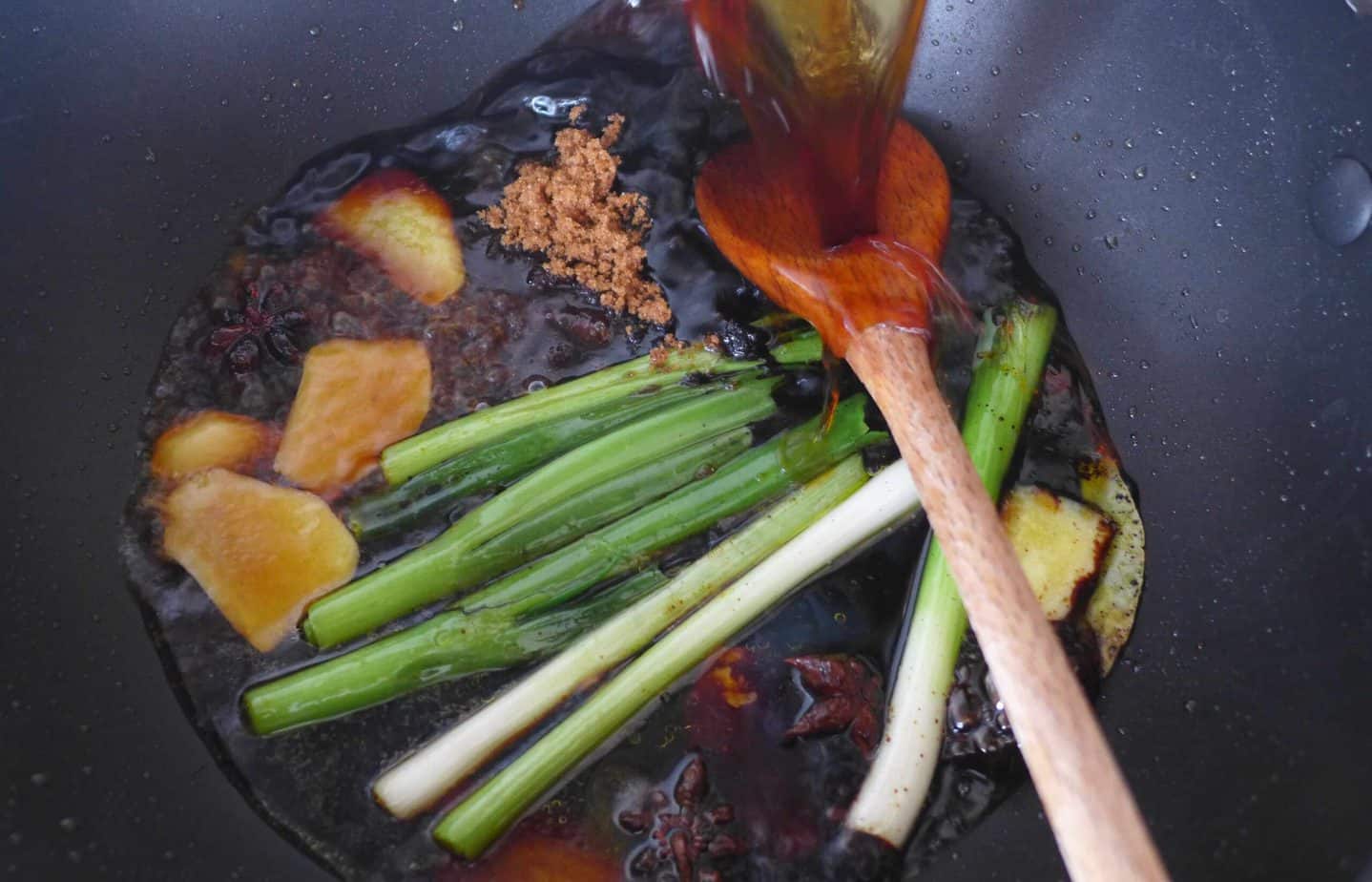
Choose a wok/pot which is big enough to lay the chicken pieces in a single layer but not so big that you need an extra-large volume of braising liquid. The first step is to fry the aromatics and spices in a little oil. Keep the heat on low to fully release their aroma without burning.
Once you smell the fragrance and see the scallions and ginger turning light brown, pour in light soy sauce, dark soy sauce, rice wine, sugar and water. Then turn up the heat to bring the liquid to a full boil.
Step 2: Simmer the chicken
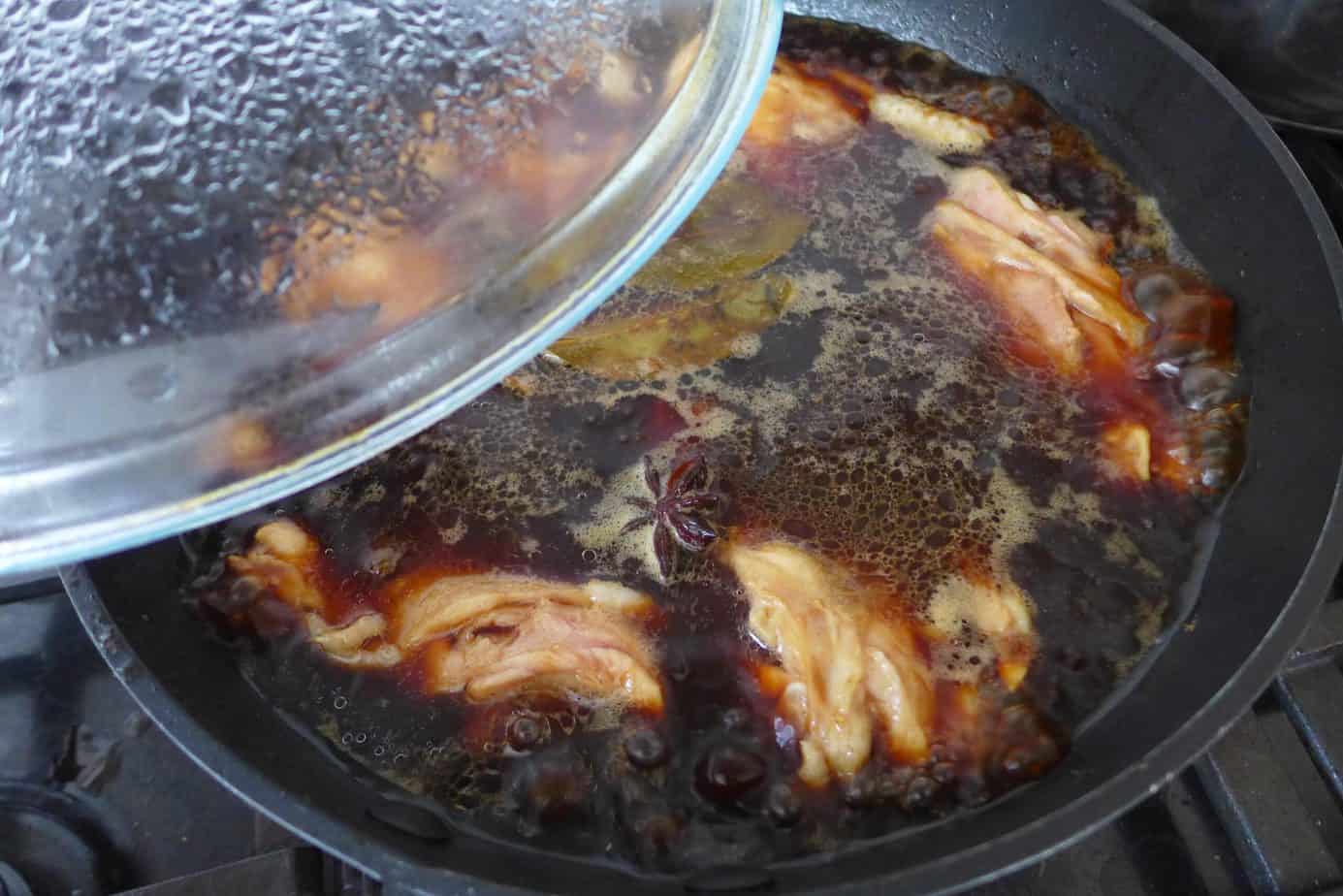
Now gently slide in the chicken thighs with the skin side down. You might need to adjust the water volume at this point. The liquid should cover at least two-thirds of the chicken.Once the bracing liquid comes back to a boil, turn the heat down to a gentle simmer. Cover with a lid and leave to cook for 35 mins. Then flip over all the thighs and cook for a further 10 mins. That’s all done!
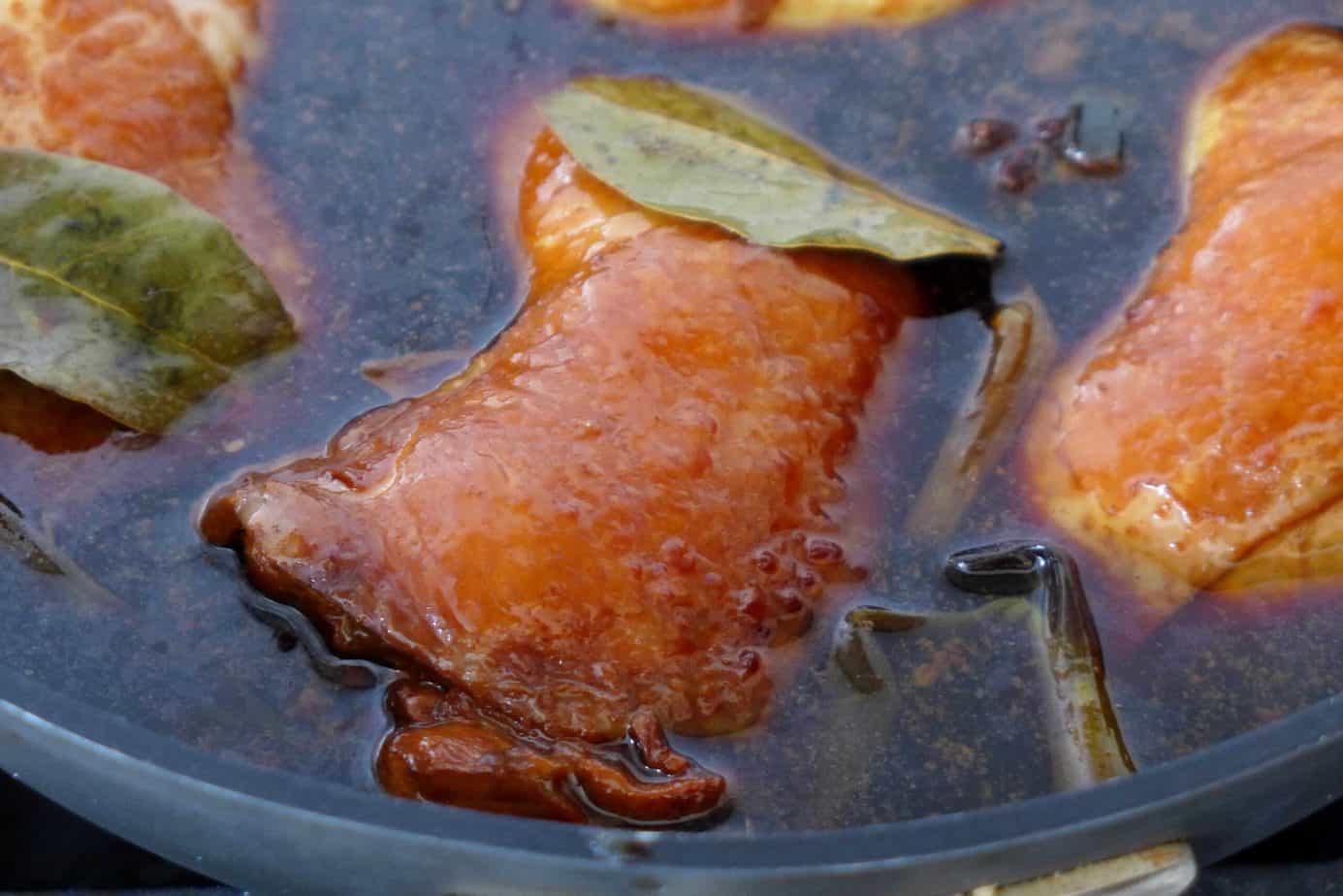
The same method applies to other cuts of chicken but you need to adjust the cooking time accordingly. Here is a general guidance: 25 mins for wings; 35 mins for drumsticks; 45-50 mins for legs or leg quarters.
If uncertain, you can test by poking the thickest part with a chopstick. It should be able to go through without much resistance. A kitchen thermometer would help too. The temperature inside the thickest part should be no lower than 74°C/165°F.
How to Serve the Chicken
Remove the bones if you wish
Once the chicken thighs are fully cooked, transfer them to a chopping board to cool. When cool, cut into bite-sized pieces. Traditionally, soy sauce chicken is served with bones in (like many other Chinese dishes as we enjoy chewing meat off the bones). You may do so if you’re confident in cutting through the bones with a cleaver. Otherwise, serve it boneless as I do.
- Lay the chicken thigh flat on the chopping board with the skin side down.
- Use the tip of the knife to cut an opening over the bone.
- Gently trim off the meat attached to the side of the bone.
- Finally, use your fingers to pull the bone out.
N.B. Of course, you could remove the bones prior to cooking. In this case, reduce the cooking time by 10 mins as it’s easier to cook through boneless pieces.
Making a quick sauce
These sliced soy sauce chicken pieces can be served on their own. Or, make a quick sauce if you like it more savoury, moist and glossy. Keep about ½ cup (120ml) of the broth in the wok/pot (read the next section for reusing the rest). Heat it up over low heat. Right before it starts to boil, pour in some cornstarch and water mixture. Remove from the heat once the sauce reaches the desired thickness. You may pour it over the chicken, or serve it in a bowl on the side for dipping.
Enjoy it in different ways
Soy sauce chicken makes a great centrepiece of a multi-course Chinese meal. Since it’s tasty, substantial, and can be easily prepared in advance, I often include it in the menus for special occasions like Chinese New Year. It has always been a crowd-pleaser!
At Cantonese style small eateries, it’s often served as a topping for all-in-one dishes: over plain rice or noodles along with some lightly seasoned vegetables. If you’re serving it this way, make sure you add extra sauce to mix with the rice/noodles.
Reuse the Cooking Liquid
Love this soy sauce chicken dish and want to make it again? Then save the leftover cooking liquid which has absorbed great flavour from the chicken. Pour it into a clean jar/container through a sieve (Discard the scallions, ginger and spices). You can reuse it within 4 days if kept in the fridge or 3 months in the freezer.
Like the Chinese Beef Master Stock I’ve shared previous, this cooking liquid can be reused indefinitely as long as you’re hygiene-cautious at each step. Its flavour will get richer and more complex over time. Please feel free to add more seasoning and spices if necessary.
Apart from using it to braise chicken (or other meat), there are other ways to enjoy it. For example, dilute it with water to make a delicious noodle soup broth; use it as a seasoning for Cantonese Steamed Fish, add a little to stir-fries as a flavour enhancer, or mix it into Dumpling Fillings.
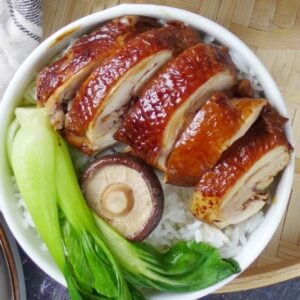
Soy Sauce Chicken (See Yao Gai, 豉油鸡)
Ingredients
- 6 chicken thighs - see note 1 for other options
- ½ tablespoon cooking oil
- 3 stalks scallions, cut in halves
- 1 thumb-sized ginger, sliced
- 3 star anise
- 2 bay leaves
- 1 cup light soy sauce - 240ml
- 2 tablespoon dark soy sauce
- 2 tablespoon Shaoxing rice wine - or Chinese rose wine
- 2 tablespoon dark brown sugar - or 40g rock sugar
- 2 cups water - 480ml
- ½ tablespoon cornstarch, mix with 1 tablespoon water
Instructions
Prepare the braising liquid
- Add oil, scallions, ginger, star anise, and bay leaves to a wok/pot. Fry over low heat until fragrant and the scallions and ginger browns a little.
- Pour in light soy sauce, dark soy sauce, Shaoxing rice wine, sugar and water. Turn the heat to high. Bring the liquid to a boil.
Cook the chicken
- Slide in the chicken thighs, skin side down (they should be in a single layer without overlapping). Adjust the water if necessary. The liquid should cover most parts of the chicken.
- When the cooking liquid comes back to a boil, turn the heat down to a gentle simmer. Cover and leave to simmer for 35 mins. Flip over all the thighs then cook for a further 10 mins (see note 1 if cooking other cuts of chicken).
Serve the chicken
- Take out the chicken. When cool enough to handle, remove the bones then slice into bite-sized pieces (see instructions in post content above).
- Keep about 120ml (½ cup) of the broth in the wok/pot then heat up. Right before it starts to boil, add the cornstarch mixture. Remove from the heat once the sauce reaches the desired thickness. Pour it over the sliced chicken, or serve it in a bowl on the side for dipping (see note 2 for serving ideas).
- The remaing broth can be reused. Pour it into a jar/container through a sieve and discard the spices.Use within 4 days if kept in the fridge or for 3 months in the freezer.
NOTES
- Chicken wings: 25 mins
- Chicken drum sticks: 35 mins
- Chicken legs or leg quarters: 45-50 mins
NUTRITION
NUTRITION DISCLOSURE: Nutritional information on this website is provided as a courtesy to readers. It should be considered estimates. Please use your own brand nutritional values or your preferred nutrition calculator to double check against our estimates.


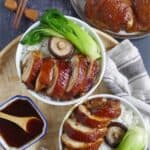
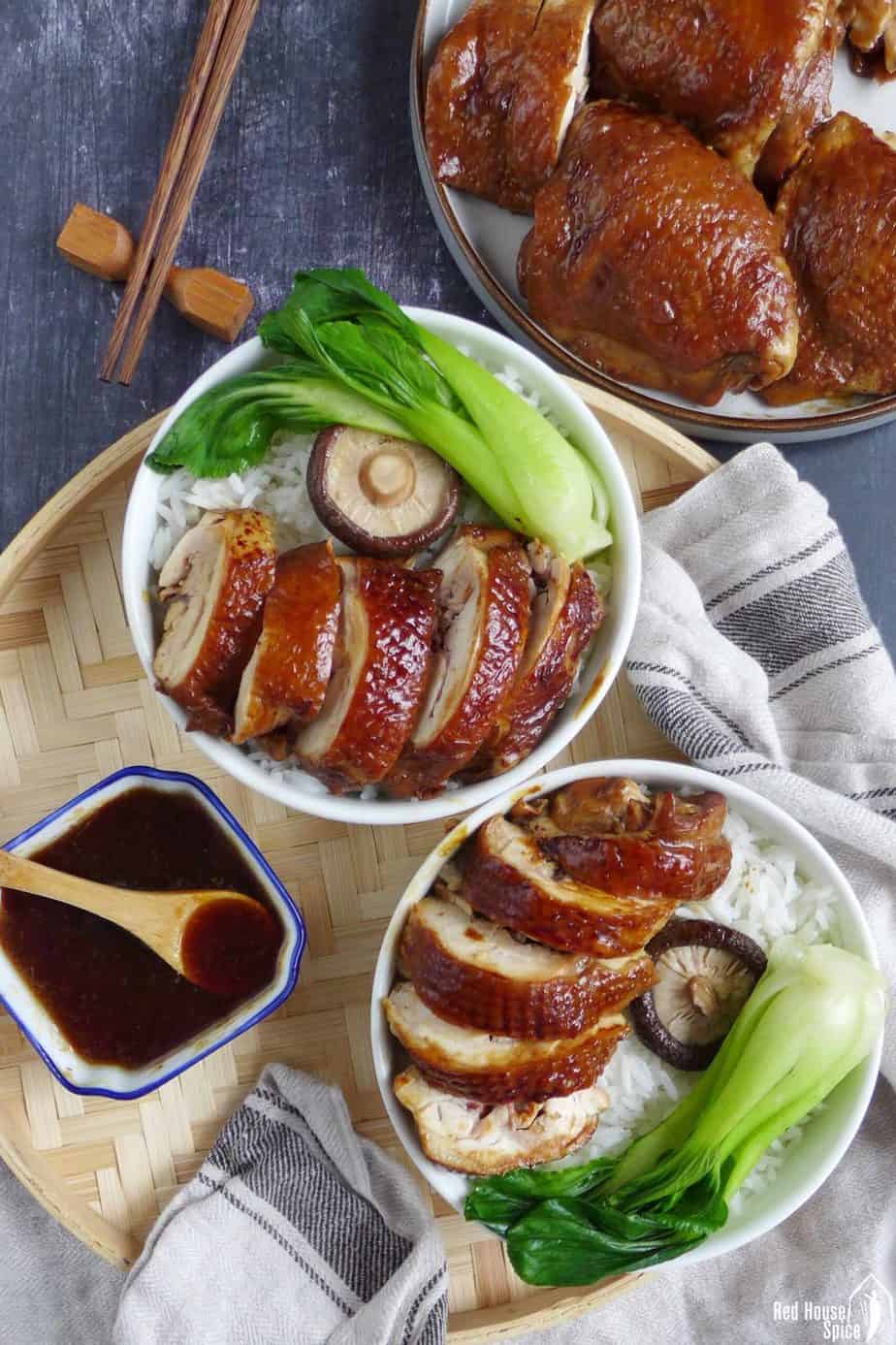
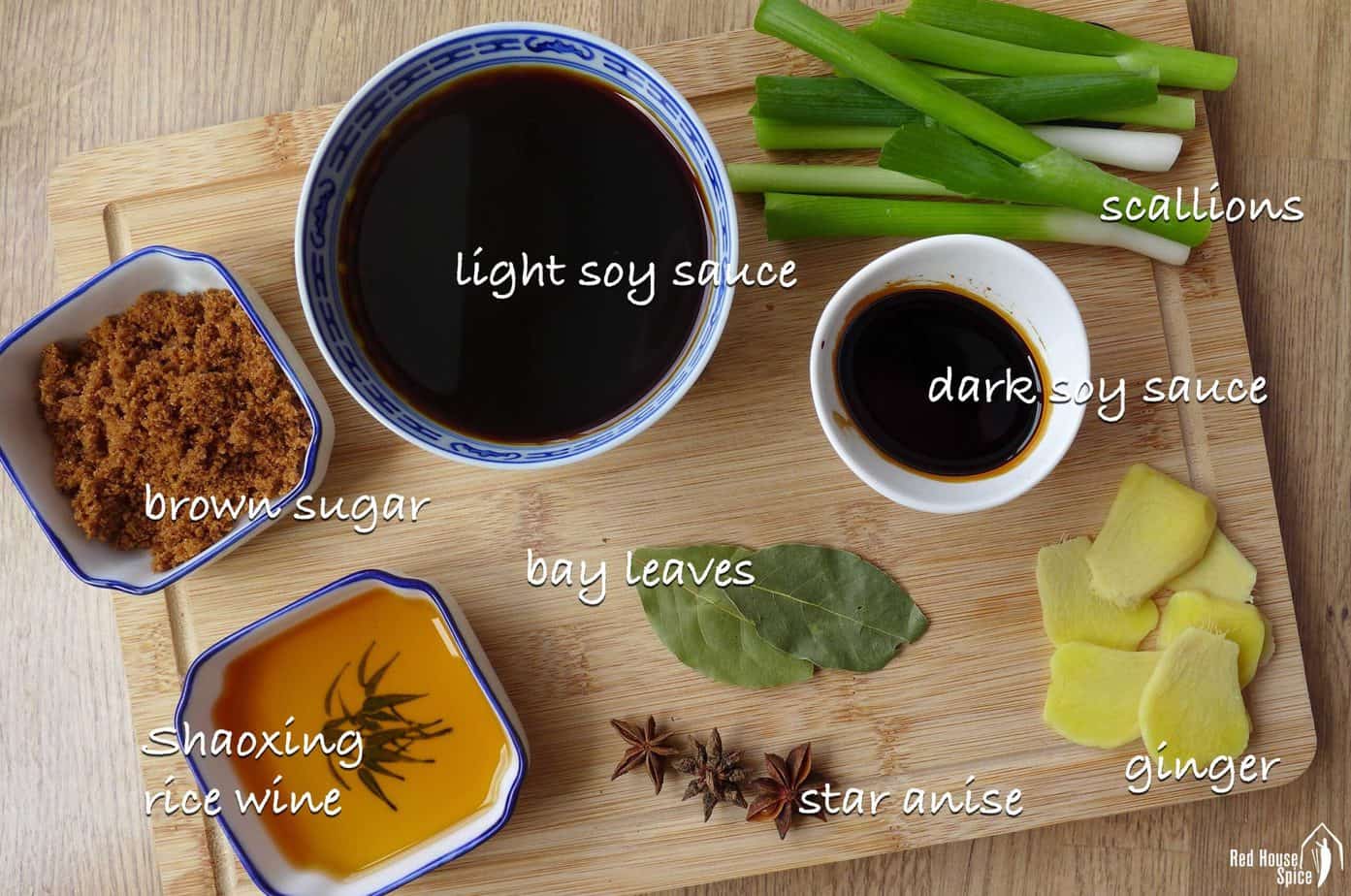
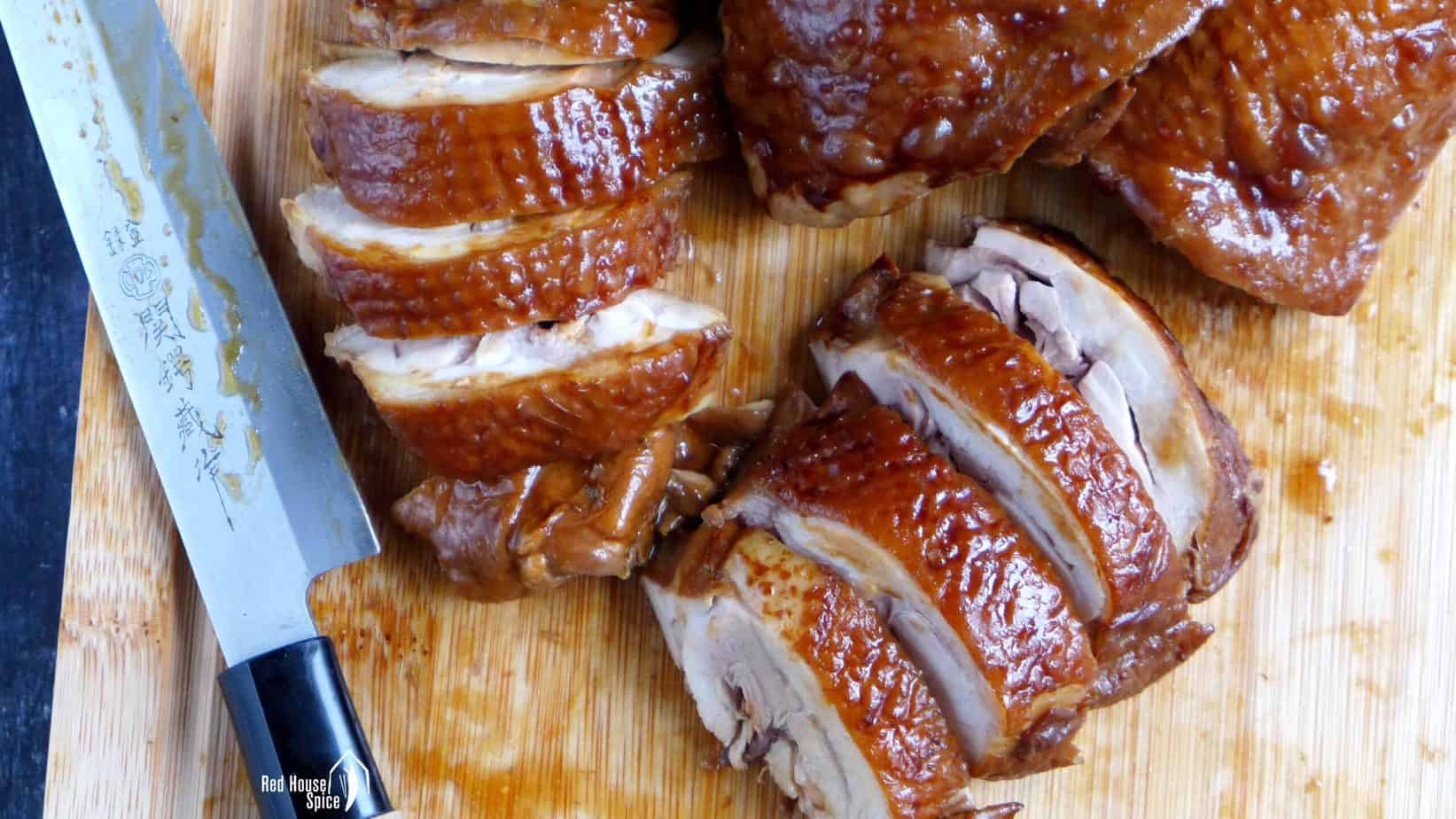
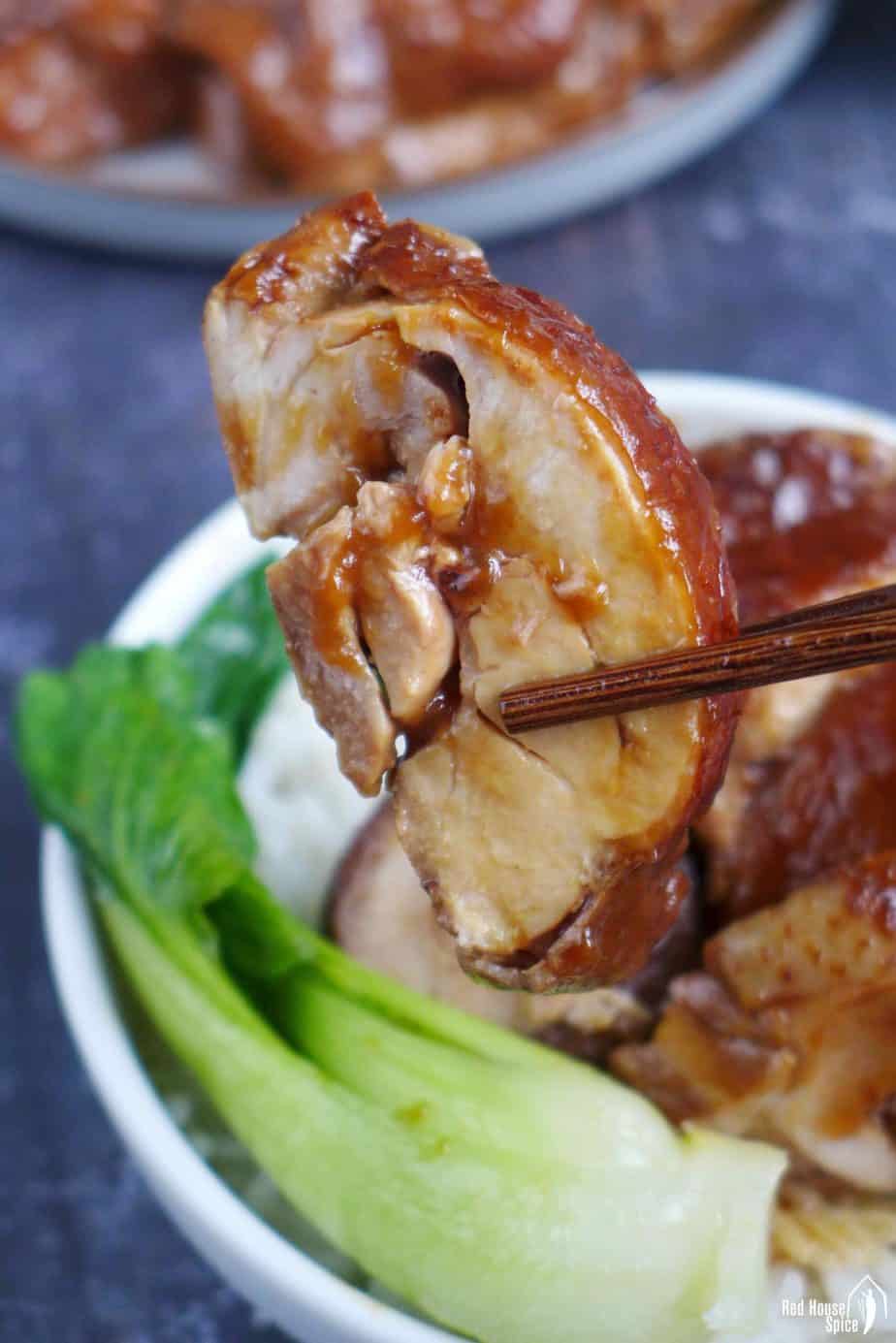
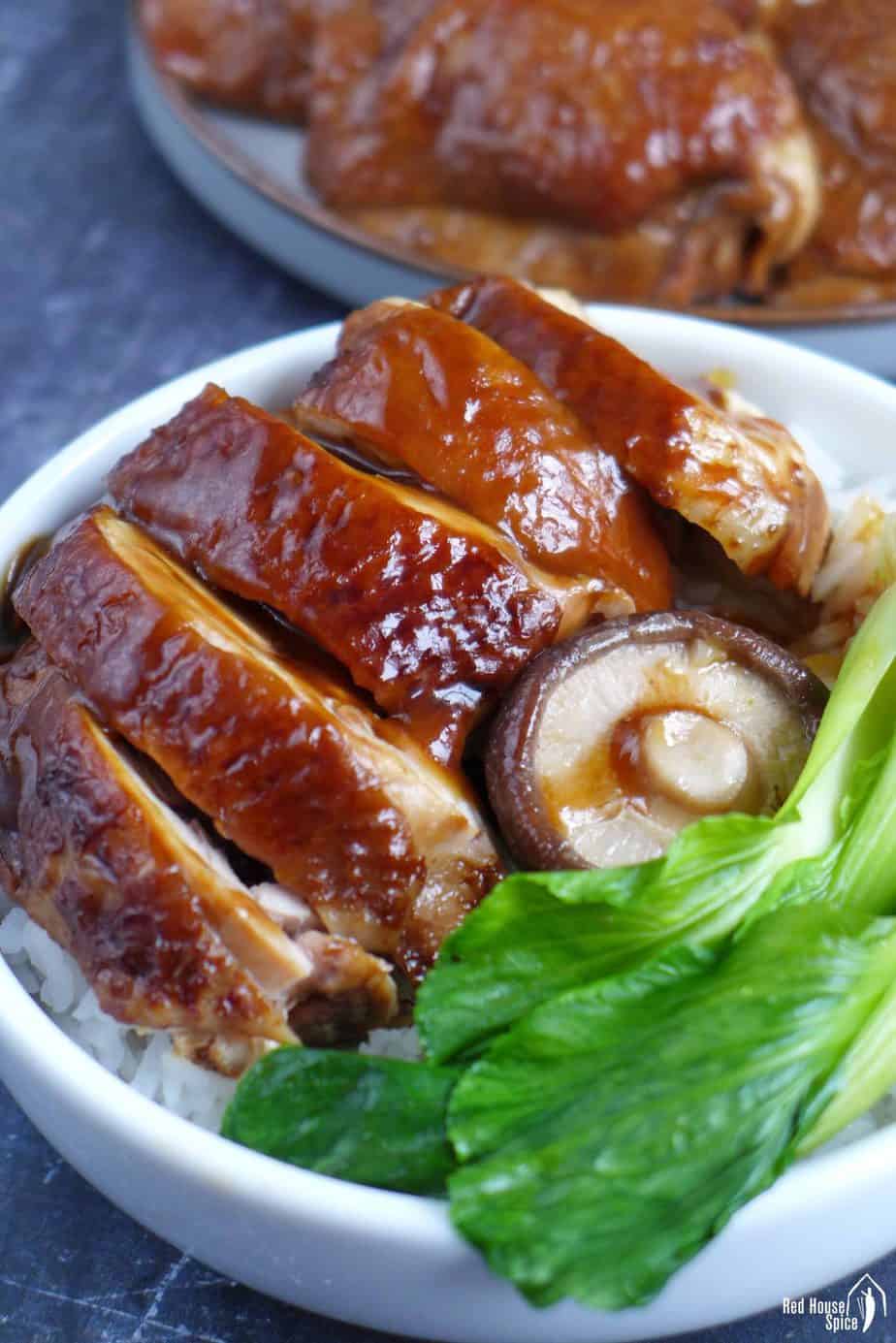

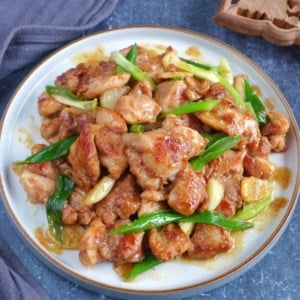
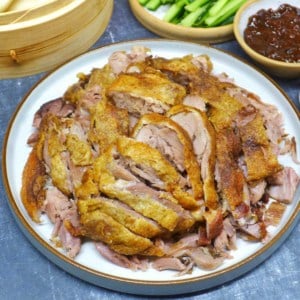

hi Wei,i am 87 years old and love chinese food have eaten and cooked it nearly all my life but when i came across your site i realised i new nothing and what i was eating was a very poor westernised copy, so thank you for putting me straight,i have chronic kidney disease and am having dialisis and hope to have many years left following your great recipes many thanks, tony.
You’re welcome Tony! Very happy to know you find my recipe inspiring. Wish you good health and a fun time cooking Chinese food!
This recipe was easy to follow and make. My Mom used to make this dish when I was young and I never learned how to make it. This recipe is darn close to what I recall it tasting like. The only thing about my soy sauce chicken is it didn’t come up as dark as it was pictured. I even used the right amount of dark soy sauce, despite that, this recipe is worth saving and dish is worthy to make again!! Thank you sharing.
Glad you enjoyed the dish Sabrina! Through tests I’ve noticed that not all chicken can be browned as nicely as desired. Sometimes you’d find a very thin layer of fat on the skin which prevents the sauce from colouring it.
Made this recipe exactly as described although I like to give recipes an personal touch. It was delicious and easy to make….!!!!
An 10 out of 10….!!!!
Thanks Wei……
Thanks for sharing this recipe it’s really good and easy to prepare. I hope I can Cook more good foods. Thank you.
Hi Wei! I made this with Kikkoman soy sauce and dry sherry and it came out great — I did think it needed a touch more sugar for balance, and I will add it when I heat up the leftovers. The remaining broth is in my freezer for the next time. Thanks for a great recipe!
Yes, please feel free to adjust as everyone has different taste preferences.
Great recipe. Thank You for giving simple instructions that can be adapted to western kitchen, especially substitutions for hard to get Chinese ingredients e.g. Shaoxing wine etc. And the measurements help as our mothers never measure and newbies like us don’t know how to estimate!
My pleasure to share Maria! I hardly measure anything when cooking regular meals for my family. But I measure everything when testing recipes for my blog. I know how important it is for people who aren’t familiar with this cuisine. Glad you enjoyed this recipe.
Thank you, Wei, for sharing this recipe. As most of my mother’s and grandmother’s recipes are based on their knowledge and not exact measurements, it is hard to figure out the proportions. Your recipe is very helpful.
I totally understand your frustration. I seldom measure anything when cooking regular meals. But for writing recipes, I measure and test multiple times. Glad to know you find my recipes helpful.
Looks really good and can’t wait to try it! Can this be done with a slow cooker?
Yes for sure. Happy cooking!
How long do you cook it if it’s a whole chicken?
If cooking a whole chicken, you’d need to increase the seasonings and water to cover at least 3/4 of the chicken. Baste with cooking liquid occasionally to ensure even colouring. I’d suggest you simmer it for 1 hour then let it sit for a further 20 mins.
Hi Wei
I cannot find any Shaoxing rice wine in my Supermarket, what can I use instead please?
Hi Jilly! For this recipe, you can replace Shaoxing rice wine with dry sherry or dry white wine. It’s also fine to skip it as the quantity is small. Happy cooking.